CBSE Class 6 Maths Sample Papers
CBSE Class 6 Maths Sample Paper Set 1
Time : 3 hrs
M.M. : 80
General Instructions :
- This question paper comprises 39 questions. All questions are compulsory.
- This question paper is divided into five sections – A, B, C, D and E.
- Section A – Questions No. 1 to 20 are multiple choice questions. Each question carries 1 mark.
- Section B – Questions No. 21 to 25 are very short answer type questions. Each question carries 2 marks.
- Section C-Questions No. 26 to 34 are short answer type questions. Each question carries 3 marks.
- Section D – Questions No. 35 to 38 are long answer type questions. Each question carries 5 marks.
- Section E-Question No. 39 is source-based/case-based question which carries 3 marks.
Section-A
Question 1.
The lowest form of \(\frac{34}{102}\) is
(a) \(\frac{3}{10}\)
(b) \(\frac{17}{42}\)
(c) \(\frac{17}{51}\)
(d) \(\frac{3}{10}\)
Answer:
(c) \(\frac{17}{51}\)
Question 2.
The perimeter of a square whose side is \(\frac{1}{4}\) cm is
(a) 2 cm
(b) 1 cm
(c) 4 cm
(d) 16 cm
Answer:
(b) 1 cm
Question 3.
The equivalent fraction of \(\frac{5}{3}\) is
(a) \(\frac{10}{9}\)
(b) \(\frac{10}{6}\)
(c) \(\frac{15}{6}\)
(d) \(\frac{15}{12}\)
Answer:
(b) \(\frac{10}{6}\)
![]()
Question 4.
Which of the following number is divisible by 4 ?
(a) 297144
(b) 32145
(c) 32346
(d) 297050
Answer:
(a) 297144
Question 5.
Which of the following option has the common factors of 75, 60 and 210?
(a) 1,3,5,10,15
(b) 1,3,5,15
(c) 1,3,5,15,60
(d) None of these
Answer:
(a) 1,3,5,10,15
Question 6.
The angle name for half a revolution is
(a) right angle
(b) straight angle
(c) complete angle
(d) obtuse angle
Answer:
(b) straight angle
Question 7.
If the perimeter of the square is 4 cm , the length of the side is
(a) 4 cm
(b) 2 cm
(c) 1 cm
(d) 3 cm
Answer:
(c) 1 cm
Question 8.
Number of integers lying between -7 and 5 is
(a) 4
(b) 6
(c) 11
(d) 7
Answer:
(c) 11
Question 9.
How many proper fractions are there in the fractions, given below
 ?
?
(a) 5
(b) 4
(c) 3
(d) 2
Answer:
(b) 4
Question 10.
Subtraction of \(\frac{3}{4}\) from \(\frac{5}{6}\) gives
(a) \(\frac{1}{3}\)
(b) \(\frac{1}{11}\)
(c) \(\frac{1}{12}\)
(d) 1
Answer:
(c) \(\frac{1}{12}\)
![]()
Question 11.
What fraction of the given figure is shaded?

(a) \(\frac{2}{3}\)
(b) \(\frac{1}{3}\)
(c) \(\frac{3}{4}\)
(d) \(\frac{4}{7}\)
Answer:
(a) \(\frac{2}{3}\)
Question 12.
Using tally marks which one of the following represents the number 17?
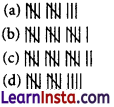
Answer:
![]()
Question 13.
The length of the wooden strip required to frame a photograph of length and breadth 30 cm and 17 cm , respectively is
(a) 102 cm
(b) 94 cm
(c) 90 cm
(d) 84 cm
Answer:
(b) 94 cm
Question 14.
Rina had a chocolate bar and ate \(\frac{1}{4}\) of it. How much of the chocolate bar is left?
(a) \(\frac{2}{3}\)
(b) \(\frac{3}{4}\)
(c) \(\frac{1}{4}\)
(d) \(\frac{2}{4}\)
Answer:
(b) \(\frac{3}{4}\)
Question 15.
Which of the following integers is the greatest?
(a) -8
(b) -3
(c) 0
(d) -5
Answer:
(c) 0
![]()
Direction (Q.Nos. 16-20) The following questions consist of two statements Assertion (A) and Reason (R). Answer these questions selecting the appropriate option given below.
(a) Both A and R are true and R is the correct explanation of A.
(b) Both A and R are true but R is not the correct explanation of A.
(c) A is true but R is false
(d) A is false but R is true.
Question 16.
Assertion (A) A right angle always measures 90°.
Reason (R) A right angle is formed when two lines are parallel to each other.
Answer:
(c) A is true but R is false
Question 17.
Assertion (A) The factors of 34 are 1, 2, 17 and 34 itself.
Reason (R) Every factor is less than or equal to the given number.
Answer:
(a) Both A and R are true and R is the correct explanation of A.
Question 18.
Assertion (A) A triangle is made of three and quadrilateral is made of four line segments. Reason (R) The measure of each line segment is a unique number called its length.
Answer:
(b) Both A and R are true but R is not the correct explanation of A.
![]()
Question 19.
Assertion (A) The fraction representing the shaded portion is \(\frac{1}{5}\).

Reason (R) A fraction is a number representing part of a whole.
Answer:
(d) A is false but R is true.
Question 20.
Assertion (A) Perimeter of the given figure is 20 cm .
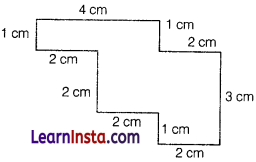
Reason (R) Perimeter is the distance covered along the boundary of a closed figure when we go around the figure once.
Or
The perimeter of a rectangle is 150 cm . If the length of rectangle is 50 cm , then find the width of the rectangle.
Answer:
(a) Both A and R are true and R is the correct explanation of A.
Section-B
Question 21.
Write the following fractions in simplest form.
(i) \(\frac{45}{85}\)
(ii) \(\frac{27}{81}\)
Answer:
(i) \(\frac{9}{17}\)
(ii) \(\frac{1}{3}\)
Question 22.
Find LCM of 32 and 64.
Answer:
64
Question 23.
The perimeter of a square is 128 cm . Find the length of each side.
Answer:
32 cm Or 25 cm
![]()
Question 24.
Construct a circle whose radius is 4.7 cm
Question 25.
Represent 3+5 on the number line.
Answer:

Section-C
Question 26.
Find the prime factorisations of the following numbers.
(a) 320
(b) 1024
Answer:
(a) 2 × 2 × 2 × 2 × 2 × 2 × 5
(b) 2 × 2 × 2 × 2 × 2 × 2 × 2 × 2 × 2 × 2
Question 27.
Represent the following numbers on a number line.
(i) +4
(ii) -12
(iii) +14
Answer:
(i)

(ii)

(iii)

Question 28.
Find the equivalent fraction of \(\frac{4}{7}\) having
(i) denominator 49
(ii) numerator 44
Answer:
(i) \(\frac{28}{49}\)
(ii) \(\frac{44}{77}\)
![]()
Question 29.
Construct a rectangle in which one of the diagonals divides the opposite angles into 35°, and 55°.
Question 30.
Compare the following fractions
(i) \(\frac{4}{5}\) and \(\frac{5}{6}\)
(ii) \(\frac{3}{4}\) and \(\frac{2}{5}\)
Or
Find two equivalent fractions of
(i) \(\frac{3}{7}\)
(ii) \(\frac{5}{9}\)
Answer:
(i) \(\frac{4}{5}\)<\(\frac{5}{6}\)
(ii) \(\frac{3}{4}\)>\(\frac{2}{5}\)
Or
(i) \(\frac{6}{14}\), \(\frac{9}{21}\)
(ii) \(\frac{10}{18}\), \(\frac{15}{27}\)
Question 31.
Radha painted \(\frac{2}{3}\) of the wall space in her room. Her brother Rahul helped and painted \(\frac{1}{5}\) of the wall space. How much did they paint together? What part of the whole space is left unpainted?
Or
Sarita first painted \(\frac{4}{7}\) of the wall space in her room. After some time she painted \(\frac{1}{5}\) of the wall space. Her son Udit helped and painted \(\frac{1}{5}\) of the wall sapce.
Find the unpainted part of the whole wall space.
Answer:
\(\frac{13}{15}\), \(\frac{2}{15}\) Or \(\frac{1}{35}\)
Question 32.
Akmal read 25 pages of a book containing 375 pages. Anmol read \(\frac{3}{5}\) of the same book. Who read less?
Answer:
Akmal
Question 33.
Find the area of the square whose perimeter is 28 m.
Answer:
39 m2
Question 34.
Ashok has a bank account with a balance of ₹ 2500 . On Monday, he deposits ₹ 1200 into his account. On Wednesday, he withdraws ₹ 1800 for some household expenses. Finally, on Friday, he receives a refund of ₹ 700, which is credited to his account. What is Ashok’s final bank balance at the end of the week?
Answer the following questions.
(i) How many books were read by students of Class 6?
(ii) Which class read the most number of books and how many?
(iii) How many more books were read by Class 9 than Class 7?
(iv) What is the total number of books read by all the classes together?
Answer:
₹ 2600
Section-D
Question 35.
A square garden has a perimeter of 96 m .
(i) What is the length of each side of the garden?
(ii) If Rohan wants to put a fence around the garden, how much fencing material will he need to cover two sides of the garden?
Or
The lawn in Mohan’s house is 12 m × 8 m whereas the lawn in front of Sohan’s house is 15 m × 5 m. A bamboo fencing is built around both the lawns. How much fencing is required for both?
Answer:
(i) 24 m
(ii) 48 m Or 80 m
Question 36.
The following pictograph shows the number of books read by students in a week in different classes of a school:

Answer:
(i) 16 books
(ii) Class-IX, 28
(iii) 4 books
(iv) 88 books
![]()
Question 37.
Anil and Ankush are two friends. If Anil and Ankush monthly salary are ₹ 25000 and ₹ 15000 respectively. Due to some emergency Ankush need \(\frac{1}{4}\) of his salary. In this situation Anil help his friend. Find how much amount of money helped by Anil. Also, find total amount of money had Ankush? What kind of value depict here?
Or
The monthly income of Mr. Suraj is ₹ 56000 . He gives \(\frac{1}{5}\) of it to his wife and \(\frac{2}{5}\) of the remaining he spends on household expenses. Find
(i) how much does Mr. Suraj give his wife?
(ii) what is the amount that is left with Mr. Suraj?
Answer:
₹ 3750 , ₹ 18750 , The value depicted here is kindness, helpful and friendly nature.
Question 38.
A piece of wire is 80 cm long. It is bent to form the following shapes.
(i) A square Calculate the length of each side and the area of the square.
(ii) A rectangle If the length of the rectangle is twice its breadth, find the dimensions of the rectangle and its area.
(iii) A regular hexagon Calculate the length of each side and the perimeter of the hexagon.
Answer:
(i) 20 cm, 800 cm2
(ii) Length =\(\frac{80}{3}\) cm,
Breadth =\(\frac{40}{3}\) cm,
Area = \(\frac{3200}{9}\) cm2
(iii) \(\frac{40}{3}\) cm, 80 cm
Section-E
Question 39.
The number of sports students in a school is depicted by the following pictograph.

Observe the pictograph and answer the following questions.
(i) Which class has the minimum number of sports students?
(ii) Which class has the maximum number of sports students?
(iii) How many sports students are there in class VI?
(iv) What is the total number of sports students from the class VI to X ?
(v) What is the difference between sports students of class VII and VIII?
Answer:
(i) Class-IX
(ii) Class-X
(iii) 60
(iv) 300
(v) 40
CBSE Class 6 Maths Sample Paper Set 2
Section-A
Question 1.
The value of 136+463-206 is
(a) 361
(b) 468
(c) 393
(d) 292
Answer:
(c) 393
Question 2.
What part of 125 is 25 ?
(a) \(\frac{1}{4}\)
(b) \(\frac{1}{6}\)
(c) \(\frac{1}{5}\)
(d) \(\frac{1}{8}\)
Answer:
(c) \(\frac{1}{5}\)
![]()
Question 3.
The sum of -18 and 18 is
(a) 0
(b) 36
(c) 18
(d) -18
Answer:
(a) 0
Question 4.
Aman’s bank account balance is ₹ 2000. He withdraws ₹ 700 and then deposits ₹ 300. What is his final balance?
(a) ₹ 1600
(b) ₹ 1700
(c) ₹ 1800
(d) ₹ 2000
Answer:
(a) ₹ 1600
Question 5.
Find the next number in the pattern.
2, 6, 12, 20, 30, _______
(a) 36
(b) 40
(c) 42
(d) 44
Answer:
(c) 42
Question 6.
The sum of two integers is -11 . If one of them is 4, then other integer is
(a) -11
(b) 12
(c) -14
(d) -15
Answer:
(d) -15
Question 7.
Area of rectangular garden is 50 m . If breadth is 3000 sq m , then the length of garden is
(a) 300 m
(b) 50 m
(c) 16 m
(d) 60 m
Answer:
(d) 60 m
Question 8.
\(\frac{5}{9}\)+\(\frac{3}{4}\)–\(\frac{7}{12}\) is equal to
(a) \(\frac{3}{15}\)
(b) \(\frac{7}{15}\)
(c) \(\frac{13}{18}\)
(d) \(\frac{11}{18}\)
Answer:
(c) \(\frac{13}{18}\)
![]()
Question 9.
The number sequence 1,3,6,10,15,21,28,_______ is sequence of
(a) even number
(b) odd number
(c) cubes
(d) triangular number
Answer:
(d) triangular number
Question 10.
In the given figure, the sum of shaded portion of fig. (i) and fig. (ii) is

(a) \(\frac{2}{4}\)
(b) \(\frac{3}{4}\)
(c) \(\frac{1}{4}\)
(d) 2
Answer:
(b) \(\frac{3}{4}\)
Question 11.
The sales of ice-cream cones of a particular week is given by the below pictograph.
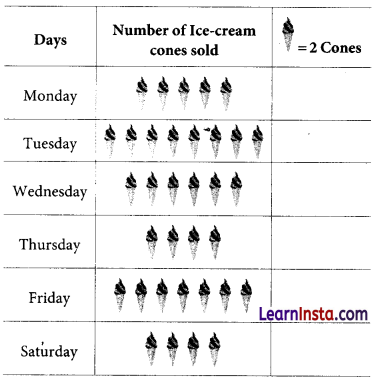
The maximum number of ice-cream cones were sold on
(a) Friday
(b) Wednesday
(c) Tuesday
(d) Thursday
Answer:
(c) Tuesday
Question 12.
The mixed fraction 5 \(\frac{4}{9}\) can be expressed as
(a) \(\frac{49}{9}\)
(b) \(\frac{48}{9}\)
(c) \(\frac{40}{9}\)
(d) \(\frac{46}{9}\)
Answer:
(a) \(\frac{49}{9}\)
Question 13.
Given the digits 3,7,1, and 9 , what are the largest and smallest 4 -digit numbers you can form using each digit exactly once?
(a) Largest: 9731, Smallest: 1379
(b) Largest: 9731, Smallest: 1739
(c) Largest: 9713, Smallest: 1379
(d) Largest: 9713, Smallest: 1397
Answer:
(a) Largest: 9731, Smallest: 1379
![]()
Question 14.
How many points are enough to fix a line?
(a) 1
(b) 2
(c) 3
(d) 4
Answer:
(b) 2
Question 15.
The largest four-digit number having distinct digit is
(a) 9768
(b) 9999
(c) 9876
(d) 9678
Answer:
(c) 9876
Direction (Q.Nos. 16-20) The following questions consist of two statements Assertion (A) and Reason (R). Answer these questions selecting the appropriate option given below.
(a) Both A and R are true and R is the correct explanation of A.
(b) Both A and R are true but R is not the correct explanation of A.
(c) A is true but R is false.
(d) A is false but R is true.
Question 16.
Assertion (A) The perfect number between 1 and 10 is 6.
Reason (R) A number for which the sum of all its factors is equal to twice number is called a perfect number.
Answer:
(a) Both A and R are true and R is the correct explanation of A.
Question 17.
Assertion (A) The perimeter of a square is always greater than the perimeter of a rectangle with the same area.
Reason (R) A square has all sides equal, while a rectangle can have different lengths and widths.
Answer:
(d) A is false but R is true.
Question 18.
Assertion (A) \(\frac{3}{7}\) is obtained when we divide a whole into seven equal parts and take three part. Reason (R) A fraction is a number representing part of a whole.
Answer:
(a) Both A and R are true and R is the correct explanation of A.
![]()
Question 19.
Assertion (A) A number is divisible by 4 if the sum of its last two digits is divisible by 4.
Reason ( R ) The divisibility rule for 4 states that a number is divisible by 4 if its last digit is divisible by 4.
Answer:
(c) A is true but R is false.
Question 20.
Assertion (A) \(\frac{3}{4}\) is greater than \(\frac{2}{3}\)
Reason (R) To compare fractions with different denominators, change the given fraction to equivalent fractions so that they all are expressed with the same denominator, then compare by simply comparing the numerators.
Answer:
(a) Both A and R are true and R is the correct explanation of A.
Section-B
Question 21.
Subtract as indicated
(i) \(\frac{13}{4}\) from \(\frac{17}{4}\)
(ii) \(\frac{18}{5}\) from \(\frac{23}{3}\)
Answer:
(i) 1
(ii) \(\frac{64}{15}\)
Question 22.
(i) In the givne figure, the angle between hour hand and minute hand is ……

(ii) Find the perimeter of a square whose side is 3 cm.
Answer:
(i) 90°
(ii) 12 cm
Or
(i) If perimeter of a square is 20 cm , then find the length of each side.
(ii) Which angle is greater ∠ B O D or ∠ C O D.

Answer:
(i) 5 cm
(ii) ∠ BOD
Question 23.
Answer the following questions.
(i) Convert \(\frac{82}{7}\) in mixed fraction.
(ii) Write common factors of 42 and 14.
Answer:
(i) 11 \(\frac{5}{7}\)
(ii) 1, 2, 7 and 14
Question 24.
Draw the line of symmetry

Answer:

Section-C
Question 25.
Write two integers whose sum is greater than both the integers.
Answer:
2 and 5
Question 26.
Construct a rectangle one of whose side is 5 cm and the diagonal is of 8 cm.
![]()
Question 27.
Find the perimeter and area of the following figure.

If the perimeter of the following figure is 60 cm , then find the area of the figure.

Answer:
24 cm and 20 cm2 Or 221 cm2
Question 28.
In an election, the successful candidate registered 477550 votes and his nearest rival secured 302846 votes. By what margin did the successful candidate win the election?
Answer:
174704
Question 29.
Subtract -5308 from the sum (-2200)+(-2003).
Or
Subtract -5555 from the sum [(-9999)+(-1111)+2222]
Answer:
1105 Or – 3333
Question 30.
What will be the angle at 3 o’clock? 4 o’clock and 11 o’clock?
Answer:
90°, 120°, 30°
Question 31.
In the following numbers, which is the greatest and which is the smallest?
38051325, 30050800, 67205804
Answer:
Greatest number = 67205804
Smallest number = 30050800
Question 32.
Find the perimeter of an equilateral triangle, if one side of the triangle is 10 cm.
Answer:
30 cm
Question 33.
A B C D is a rectangle (as shown below). Find the perimeter of rectangle A B C D and area of rectangle.

Answer:
42 cm, 104 cm2
![]()
Question 34.
A piece of a wire \(\frac{7}{8}\) m long broke into two pieces. One piece was \(\frac{1}{4}\) m long. How long is the other piece?
Answer:
\(\frac{5}{8}\) m
Section-D
Question 35.
A rectangle and a square have the same perimeter (see the figure).

(i) The area of the rectangle is _______.
(ii) The area of the square is _______.
Answer:
(i) 15 sq units
(ii) 16 sq units
Question 36.
The following table shows the number of apples, bananas and oranges sold in a fruit shop over a week.
| Fruit | Number Sold |
| Apples | 30 |
| Bananas | 45 |
| Oranges | 25 |
| Grapes | 40 |
| Mangoes | 35 |
| Strawberries | 20 |
| Pears | 30 |
(i) Create a bar graph to represent the number of each type of fruit sold.
(ii) Which fruit was sold the most?
(iii) Which fruit was sold the least?
(iv) Find the difference between the maximum and minimum number of fruits sold.
Answer:
(i)

(ii) Banana
(iii) Strawberry
(iv) 25
Question 37.
Find the remainders obtained when each of the following numbers 84, 152, 271, 639, 810, 1124 and 1987 is divided by 10.
Answer:
4, 2, 1, 9, 0, 4 and 7
Or
Find the remainders obtained when each of the following numbers 72,83,194,1120,988,123 and 787 is divided by 2.
Answer:
0, 1, 0, 0, 0, 1, 1
![]()
Question 38.
The cost of flooring a room at ₹ 92 per m2 is ₹ 9108 . If the length of the room is 9 m , then find its breadth.
Or
Shivanshu wants to cover his room which is 3 m wide and 4 m long by squared tiles. If each square tiles is of side 0.5 m , then find the number of tiles required to cover the floor of his room.
Answer:
11 m Or 48 tiles
Section-E
Question 39.
Ramesh has a electronic shop. He has given a task to his employee to’make the pictograph of the sale of electric bulbs on different days of a week which is shown below

Observe the pictograph and answer the following questions
(i) How many bulbs were sold on Friday?
(ii) On which day were the maximum number of bulbs sold?
(iii) On which of the days same number of bulbs were sold?
(iv) On which of the days minimum number of bulbs were sold?
(v) If one big carton can hold 16 bulbs. How many cartons were needed in the given week?
Answer:
(i) 28 bulbs
(ii) Sunday
(iii) Wednesday and Saturday
(iv) Wednesday and Saturday
(v) 11
CBSE Class 6 Maths Sample Paper Set 3
Section-A
Question 1.
\(\frac{29}{5}\) in mixed fraction can be written as
(a) 5 \(\frac{5}{4}\)
(b) 5 \(\frac{4}{5}\)
(c) 5 \(\frac{1}{5}\)
(d) 6 \(\frac{1}{5}\)
Answer:
(b) 5 \(\frac{4}{5}\)
Question 2.
If the side length of a square is 8 cm , what is its area?
(a) 16 cm2
(b) 32 cm2
(c) 64 cm2
(d) 128 cm2
Answer:
(c) 64 cm2
Question 3.
Which of the following is not prime number?
(a) 13
(b) 17
(c) 22
(d) 29
Answer:
(a) 13
![]()
Question 4.
Common multiple of 3 and 12 is
(a) 30
(b) 36
(c) 51
(d) 27
Answer:
(b) 36
Question 5.
If side of an equilateral triangle is 12 cm , then its perimeter is
(a) 24 cm
(b) 36 cm
(c) 12 cm
(d) 18 cm
Answer:
(b) 36 cm
Question 6.
Add \(\frac{4}{5}\)+\(\frac{2}{3}\)
(a) \(\frac{6}{8}\)
(b) \(\frac{22}{15}\)
(c) \(\frac{3}{4}\)
(d) \(\frac{11}{3}\)
Answer:
(b) \(\frac{22}{15}\)
Question 7.
Which of the following is not in the simplest form?
(a) \(\frac{7}{5}\)
(b) \(\frac{15}{20}\)
(c) \(\frac{27}{28}\)
(d) \(\frac{13}{33}\)
Answer:
(b) \(\frac{15}{20}\)
Question 8.
The marks (out of 20) obtained by 25 students in a Mathematics test are listed as below
18, 11, 12, 6, 15, 15, 11, 10, 9, 17, 18, 13, 10, 9,7,16,11,10,18,19,7,11,18,13,14
The number of students who obtained marks more than or equal to 11 is
(a) 12
(b) 16
(c) 18
(d) 17
Answer:
(d) 17
![]()
Question 9.
The difference between the greatest and the least number that can be written by using the digit 7,3,9,5,4 will be equal to
(a) 62964
(b) 57036
(c) 21062
(d) 32609
Answer:
(a) 62964
Question 10.
In the given figure, the perimeter of the figure is

(a) 26 cm
(b) 16 cm
(c) 24 cm
(d) 8 cm
Answer:
(c) 24 cm
Question 11.
The smallest prime number is
(a) 1
(b) -1
(c) 2
(d) \(\frac{1}{2}\)
Answer:
(c) 2
Question 12.
Find the perimeter of the given figure

(a) 70 cm
(b) 60 cm
(c) 40 cm
(d) 90 cm
Answer:
(d) 90 cm
![]()
Question 13.
Using tally marks, which one of the following represents the number 7 ?
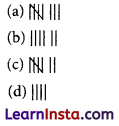
Answer:
![]()
Question 14.
The prime number between 80 and 90 is
(a) 81
(b) 82
(c) 83
(d) 85
Answer:
(c) 83
Question 15.
The difference between the largest three digit number and the largest three digit number with distinct digits is
(a) 10
(b) 12
(c) 0
(d) 13
Answer:
(b) 12
Direction (Q.Nos. 16-20) The following questions consist of two statements Assertion (A) and Reason (R). Answer these questions selecting the appropriate option given below.
(a) Both A and R are true and R is the correct explanation of A.
(b) Both A and R are true but R is not the correct explanation of A.
(c) A is true but R is false.
(d) A is false but R is true.
Question 16.
Assertion (A) A page is 25 cm long and 20 cm wide. The area of this page is 500 cm2.
Reason (R) The amount of surface enclosed by a closed figure is called its perimeter.
Answer:
(c) A is true but R is false.
Question 17.
Assertion (A) \(\frac{6}{9}\) is equivalent to \(\frac{2}{3}\).
Reason (R) We can get equivalent fraction by multiplying or dividing the numerator and denominator by the same number.
Answer:
(a) Both A and R are true and R is the correct explanation of A.
Question 18.
Assertion (A) The factors of 8 are 1, 2, 4 and 8 itself.
Reason (R) Every factor is less than or equal to the given number.
Answer:
(a) Both A and R are true and R is the correct explanation of A.
![]()
Question 19.
Assertion (A) The fraction representing the unshaded portion is \(\frac{1}{3}\).

Reason (R) A fraction is a number representing part of a whole.
Answer:
(d) A is false but R is true.
Question 20.
Assertion (A) The value of 6-9 is -3.
Reason (R) If a larges positive is subtracted from a small positive, the result is negative.
Answer:
(a) Both A and R are true and R is the correct explanation of A.
Section-B
Question 21.
Name all the angles in the given figure.

Answer:
∠ ABC, ∠ BDC, ∠ DCA and ∠ CAB
Or
Name the angle marked in the given figure

Answer:
∠ AOC and ∠ BOC
Question 22.
Answer the following question.
(i) Write greatest five digits number using 6, 8, 4, 2,1.
(ii) Find the difference between the largest 4 -digit number and the largest 3 -digit number.
Answer:
(i) 86421
(ii) 9000
Question 23.
Write the least common multiple of 25 and 75.
Answer:
75
Question 24.
Find the common factors of 38 and 62.
Answer:
1 and 2
Question 25.
Answer the following questions.
(i) What fraction of an hour is 45 min ?
(ii) Write an equivalent fraction of \(\frac{5}{11}\) having numerator 20.
Answer:
(i) \(\frac{3}{4}\)
(ii) \(\frac{20}{44}\)
Section-C
Question 26.
In the given figure, find the perimeter and area.

Answer:
24 cm, 20 cm2
or
A rectangular plot of length 200 m and breadth 150 m is to be fenced with two rows of wires. What is the length of wire needed?
Answer:
1400 m
![]()
Question 27.
Represent the following numbers on the number line.
(i) +6
(ii) -2
(iii) +4
Answer:
(i)

(ii)

(iii)

Question 28.
Write first five multiples of
(i) 7
(ii) 8
(iii) 9
Answer:
(i) 7,14,21,28 and 35
(ii) 8,16,24,32 and 40
(iii) 9, 18, 27, 36 and 45
Question 29.
What fraction of a day is
(i) 9 h
(ii) 10 h
Answer:
(i) \(\frac{3}{8}\)
(ii) \(\frac{5}{12}\)
Question 30.
Find common factors of 8,16 and 32.
Answer:
1, 2, 4 and 8
Question 31.
A floor is 6 m long and 5 m wide. A square carpet of side 2 m is laid on the floor, then find the area of the floor that is not covered by the carpet.
Answer:
26 m2
or
A rectangular piece of lawn is 55 m wide and 98 m long. Find the length of the fence around it.
Also, find the area of this piece of lawn.
Answer:
306 m, 5390 m2
Question 32.
In a laboratory, blood gruup of 20 people are recorded as given below. Make a table using tally marks.
B, O, A B, A, A, A, O, B, A B, B
A, B, O, O, A B, A B, B, O, A, O
Answer:

Question 33.
Thirty students were interviewed to find out they want to be in future. There responses are listed as below.
doctor, engineer, doctor, pilot, officer, doctor. engineer, doctor, pilot, officer, pilot, engineer, officer, pilot, doctor, engineer, pilot, officer. doctor, officer, doctor, pilot, engineer, doctor, pilot, officer, doctor, pilot, doctor, engineer.
Arrange the data in a table using tally marks.
Answer:
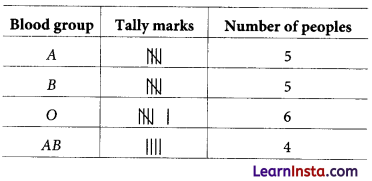
![]()
Question 34.
Compute each of the following
(i) 40+(-35)+(-20)
(ii) (-30)+(-15)
(iii) -60+(-70)+60
(iv) (0)-2-(-2)
Or
A room 9.68 m long and 6.2 m wide. Its floor is to be covered with glazed tiles of 22 cm by 10 cm each. If rate of tiles is ₹ 25 per tile. Find the total cost of tiles.
Answer:
(i) -15
(ii) -45
(iii) -70
(iv) 0
Section-D
Question 35.
Yashi has a packet of 30 biscuits. She gives \(\frac{1}{3}\) of them to Yana and \(\frac{1}{6}\) of them to Jaya. The rest she keeps.
(i) How many biscuits does Yana get?
(ii) How many biscuits does Jaya get?
(iii) How many biscuits does Yashi keep?
Answer:
(i) 10 biscuits
(ii) 5 biscuits
(iii) 15 biscuits
Question 36.
Length of a rectangular field is 150 m and width is 100 m . Anushka runs around the field two times. How far did she run? How many times she should run around the field to cover a distance of 5 km ?
Or
A rectangular piece of lawn is 55 m wide and 98 m long. Find the length of the fence around it.
Also, find the area of this piece of lawn.
Answer:
1000 m, 10 rounds
Question 37.
The perimeter of square garden is 48 m . A small floral print covers 18 sq m area inside the garden. What is the area of the garden that is not covered by the floral print? What fractional part of the garden is covered by floral print? Find the ratio of the area covered by the floral print and the remaining area.
Answer:
126 sq m, \(\frac{1}{8}\), 1: 7
Or
A marble measure 10 cm × 12 cm. How many tiles will be required to cover a wall of size. 3 m × 4 m ? Also, find the total cost of the tiles at the rate of ₹ 15 per tile.
Answer:
₹ 68200
![]()
Question 38.
The following pictograph depicts the information about the areas in sq km.

(i) What is the area of Kolkata city?
(ii) How many city have area more than 2000 sq km?
(iii) What is the difference between the area of Bhopal and Jamshedpur?
(iv) What is the total area covered by all cities?
(v) Which city area is two times of other city?
Answer:
(i) 4000 sq km
(ii) 3 cities
(iii) 1000 sq km
(iv) 15000 sq km
(v) Area of Kolkata is two times of area of Jamshedpur
Section-E
Question 39.
A child was given 7 quiz tests and scores of his test were recorded as follows
-4,0,+5,-3,+6,-1
(i) What is the lowest score the child got?
(ii) What is the difference between the highest and the lowest score?
(iii) Find the sum of -4,0,+5,-3,+6,-1
(iv) Which integer lies to the extreme right on the number line?
(v) Which integer lies to the extreme left on the number line?
Answer:
(i) -4
(ii) 10
(iii) +3
(iv) +6
(v) -4
Also Read
- Ganita Prakash Class 6 Solutions
- Class 6 Maths MCQ (Ganita Prakash)
- Class 6 Maths Notes (Ganita Prakash)
- NCERT Solutions for Class 6